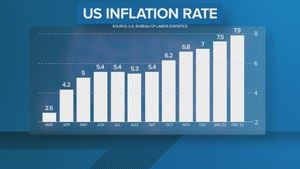The world continues to grapple with the long-term effects of the COVID-19 pandemic as new studies reveal significant shifts across mental health, substance abuse, and gender disparities. Current research suggests pandemic-induced behaviors and conditions linger, impacting society's collective fabric.
One of the most troubling aspects of the post-pandemic reality is the persistent rise in alcohol consumption among adults. A comprehensive study from Keck Medicine of USC highlights staggering statistics: from 2018 to 2020, heavy alcohol use soared by 20 percent, and this alarming trend did not simply resolve as the pandemic eased. Instead, levels of alcohol consumption remained unnaturally high even through 2022.
Interestingly, this increase spanned across demographics, though certain groups experienced it more acutely. Adults aged 40-49 represented the highest increase in heavy drinking, pointing to unique stressors faced during the pandemic’s peak. Dr. Brian P. Lee, the study’s principal investigator, articulated the urgency of addressing these concerning patterns, emphasizing how excessive drinking could pose severe public health threats.
The feelings of isolation and stress driven by lockdowns and health fears often pushed individuals to seek "liquid courage" as solace, leading to normalized drinking habits. Although the study did not explore the psychological underpinnings of this trend, Dr. Lee speculates disruptive life changes prompted by the pandemic were likely catalysts for the rise, particularly among those already vulnerable to alcohol misuse.
Also on the radar is the stark gender disparity evident during the pandemic. A retrospective study examining excess mortality rates revealed men faced significantly higher mortality compared to women, particularly among those above 45 years old. Surprisingly, countries categorized as high-income observed more severe gender gaps than their middle-income counterparts. This trend was reportedly exacerbated during the initial pandemic phase, showcasing the need for targeted public health strategies as vaccination efforts ramp up.
According to the findings, this gender imbalance became less pronounced as 2021 unfolded, largely due to accelerated vaccination rollout. The record shows the gender mortality gap might diminish over time, but the need for sustained health education and policy adaptations remains. Especially relevant, the study underlines the intersection of gender and economic status—men’s mortality rates indicated vulnerability strongly correlated with socio-economic factors, emphasizing equity-driven healthcare approaches.
Public health professionals are now faced with the challenge of addressing these intertwined long-term effects of COVID-19. Health screenings for individuals struggling with alcohol consumption have never been more necessary. Dr. Lee and his team are advocating increased awareness and preventative measures for those at risk of substance abuse as we continue to adjust to life after COVID-19.
While pervasive anxiety and uncertainty from the pandemic impact all age groups, it has disproportionately affected younger populations. New research has surfaced concerning the mental health outcomes for children and adolescents who experienced the pandemic’s impacts, particularly as they navigate school environments. These children, identified as the "youngest pandemic generation," now carry school-related challenges shaped by their unique experiences during lockdowns and periods of remote learning.
Reports indicate these young individuals reflect higher rates of anxiety and depressive symptoms, potentially resulting from prolonged isolation and disruptions to their usual social interactions during formative years. Experts advise closely monitoring and addressing educational and social supports necessary for these students, underscoring the importance of mental well-being tied to their academic success.
The reality is, the fallout from the COVID-19 pandemic is multifaceted, requiring nuanced and comprehensive strategies for recovery. Understanding patterns of substance abuse, alongside tackling the mental health crisis associated with young people’s experiences during the pandemic, is integral to formulating future public health responses.
Further complicity arises from existing barriers to accessing mental health services, with inequalities dictated along income levels and geographic regions. Comprehensive studies, such as those from the Journal of Infectious Disease, highlight systemic deficiencies affecting women and low-income communities differently, affecting long-term health outcomes.
The ramifications of COVID-19 are far-reaching, and as society continues its recovery, it will demand resilient adaptation strategies. The need for solutions addressing these myriad impacts, including substance abuse dependency and mental health, is more urgent than ever. Stakeholders will need to cultivate open dialogues around treatment accessibility, fostering environments of healing and support. How we collectively respond to these challenges will shape our communities moving forward.
Finally, these studies provide not just statistical insight but serve as calls to action. It’s imperative for healthcare providers, policymakers, and advocates to forge new paths, ensuring holistic care for those who’ve suffered through this unprecedented time. Whether it’s reducing alcohol consumption rates, alleviating mental health crises, or addressing gender disparities, our approach must be as multifaceted as the challenges posed by the pandemic itself. The path to recovery requires unity, resilience, and above all, empathy for one another's struggles.



